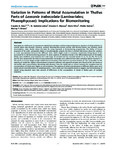Variation in Patterns of Metal Accumulation in Thallus Parts of Lessonia trabeculata (Laminariales; Phaeophyceae): Implications for Biomonitoring
| dc.contributor.author | Sáez, CA | |
| dc.contributor.author | Lobos, MG | |
| dc.contributor.author | Macaya, EC | |
| dc.contributor.author | Oliva, D | |
| dc.contributor.author | Quiroz, W | |
| dc.contributor.author | Brown, MT | |
| dc.date.accessioned | 2015-12-10T09:40:50Z | |
| dc.date.available | 2015-12-10T09:40:50Z | |
| dc.date.issued | 2012 | |
| dc.identifier.issn | 1932-6203 | |
| dc.identifier.issn | 1932-6203 | |
| dc.identifier.other | ARTN e50170 | |
| dc.identifier.uri | http://hdl.handle.net/10026.1/3908 | |
| dc.description.abstract |
Seaweeds are well known to concentrate metals from seawater and have been employed as monitors of metal pollution in coastal waters and estuaries. However, research showing that various intrinsic and extrinsic factors can influence metal accumulation, raises doubts about the basis for using seaweeds in biomonitoring programmes. The thallus of brown seaweeds of the order Laminariales (kelps) is morphologically complex but there is limited information about the variation in metal accumulation between the different parts, which might result in erroneous conclusions being drawn if not accounted for in the biomonitoring protocol. To assess patterns of individual metals in the differentiated parts of the thallus (blade, stipe, holdfast), concentrations of a wide range of essential and non-essential metals (Fe, Cr, Cu, Zn, Mn, Pb, Cd, Ni and Al) were measured in the kelp Lessonia trabeculata. Seaweeds were collected from three sampling stations located at 5, 30 and 60 m from an illegal sewage outfall close to Ventanas, Chile and from a pristine location at Faro Curaumilla. For the majority of metals the highest concentrations in bottom sediment and seaweed samples were found at the site closest to the outfall, with concentrations decreasing with distance from the outfall and at control stations; the exception was Cd, concentrations of which were higher at control stations. The patterns of metal concentrations in different thallus parts were metal specific and independent of sampling station. These results and the available literature suggest that biomonitoring of metals using seaweeds must take account of differences in the accumulation of metals in thallus parts of complex seaweeds. | |
| dc.format.extent | e50170-e50170 | |
| dc.format.medium | Print-Electronic | |
| dc.language | en | |
| dc.language.iso | eng | |
| dc.publisher | Public Library of Science (PLoS) | |
| dc.subject | Analysis of Variance | |
| dc.subject | Chile | |
| dc.subject | Environmental Monitoring | |
| dc.subject | Geologic Sediments | |
| dc.subject | Metals, Heavy | |
| dc.subject | Phaeophyceae | |
| dc.subject | Spectrum Analysis | |
| dc.subject | Water Pollutants, Chemical | |
| dc.title | Variation in Patterns of Metal Accumulation in Thallus Parts of Lessonia trabeculata (Laminariales; Phaeophyceae): Implications for Biomonitoring | |
| dc.type | journal-article | |
| dc.type | Article | |
| plymouth.author-url | https://www.ncbi.nlm.nih.gov/pubmed/23166836 | |
| plymouth.issue | 11 | |
| plymouth.volume | 7 | |
| plymouth.publication-status | Published online | |
| plymouth.journal | PLoS ONE | |
| dc.identifier.doi | 10.1371/journal.pone.0050170 | |
| plymouth.organisational-group | /Plymouth | |
| plymouth.organisational-group | /Plymouth/Faculty of Science and Engineering | |
| plymouth.organisational-group | /Plymouth/REF 2021 Researchers by UoA | |
| plymouth.organisational-group | /Plymouth/REF 2021 Researchers by UoA/UoA06 Agriculture, Veterinary and Food Science | |
| plymouth.organisational-group | /Plymouth/Research Groups | |
| plymouth.organisational-group | /Plymouth/Research Groups/Marine Institute | |
| dc.publisher.place | United States | |
| dcterms.dateAccepted | 2012-10-22 | |
| dc.identifier.eissn | 1932-6203 | |
| dc.rights.embargoperiod | Not known | |
| rioxxterms.versionofrecord | 10.1371/journal.pone.0050170 | |
| rioxxterms.licenseref.uri | http://www.rioxx.net/licenses/all-rights-reserved | |
| rioxxterms.licenseref.startdate | 2012 | |
| rioxxterms.type | Journal Article/Review |


